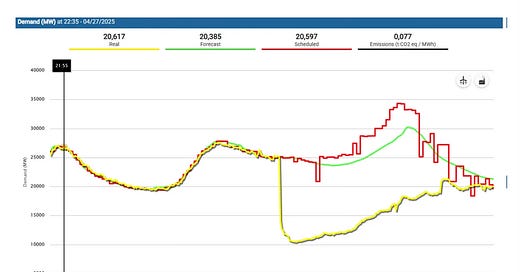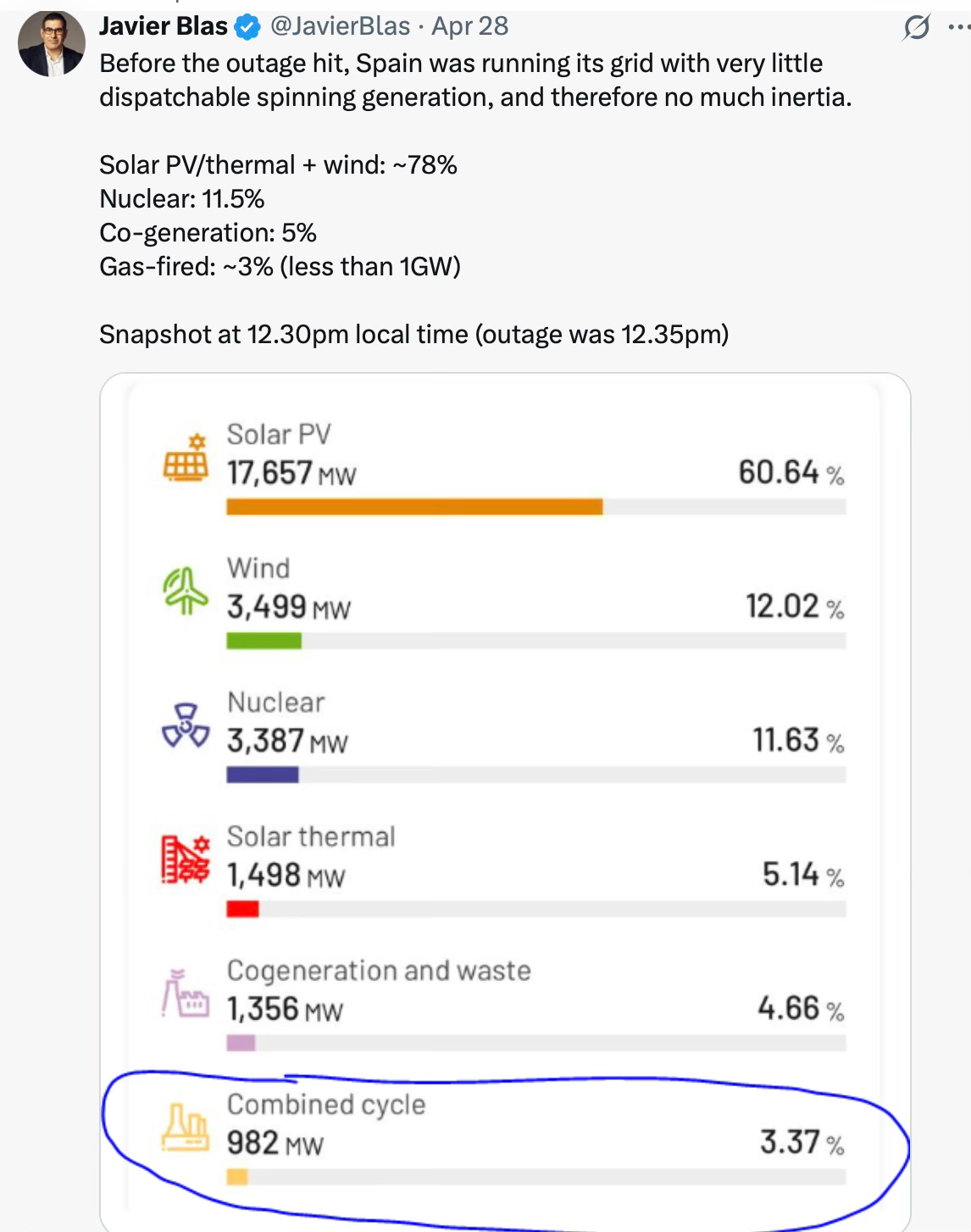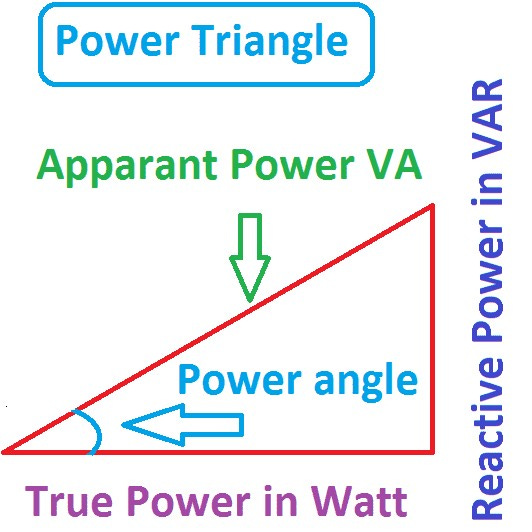On April 28,2025, Spain’s electricity production dropped from 25,000 MW to 10,000 MW at around 12:30 p.m.
Chart from Energy Bad Boys based on the Spanish data dashboard.
Spinning and Switching
On April 28, 2025, around noon on a sunny day, most of the Spanish and Portuguese power grid failed. Suddenly.
Within 30 seconds, the Iberian peninsula was blacked out, as if someone had turned off the switch.
Indeed, the grid had switched itself off. The Iberian grid was depending heavily on solar, and the solar was depending heavily on switches. The switches have a fancy name (inverters), but at the core, they are still switches.
Thermal (gas, coal, nuclear) power plants and hydro plants run on a different system: they have huge spinning generators, not inverters. The generators are big, they are spinning, and they want to keep spinning. They have inertia.
When you turn off a light, you flick a switch. In contrast, when you want to stop your car, you have to deal with the fact that your car wants to keep going and the wheels want to keep spinning. If you are driving down the road and encounter a small bump, your wheels will keep turning. If you want to stop the car, you need to apply force to the wheels (brakes). Your car will not automatically stop when there is a small problem on the road. Car wheels have regular inertia, and their wheels have rotational inertia, just like the generators in traditional power plants.
In contrast, when a switch turns off, something must turn it on again.
Generators at a relatively small hydro plant in Bavaria
Things are different on a power grid, of course. There are fail-safe mechanisms for both traditional spinning generators and for switches (Inverter-Based Resources IBRs). They will disconnect from the grid if they detect a situation where the grid (or the power plant) is likely to be damaged by changes in frequency or voltage. So both types of systems can turn themselves off if they face a problem
Texas
However, IBRs are far more sensitive to problems than spinning generators are. IBRs don’t ride through small faults easily. They can even amplify faults.
Many people look at Spain and say, “Wow, this has never happened before.” However, this type of problem with IBRs has happened many times before. I will describe one of the “Odessa Incidents.” These incidents occurred during fine weather in Odessa, Texas.
There were several related Odessa incidents, in 2021 and 2022. During the first one, in May 2021, a surge arrestor tripped at a combined cycle power plant, and the power plant (192 MW) went offline. Quickly following the power plant going offline, 1100 MW of IBR wind and solar went offline. A quote from NERC’s report on the incident (emphasis added):
“None of the affected inverter-based resources were tripped consequentially by the fault itself. Rather, all reductions (in output) were due to inverter-level or feeder-level tripping or control system behavior within the resources.”
At the time of the fault, the Texas grid had about 47,000 MW online. IBRs (wind and solar) were 43% of Texas generation, while 56% of Texas generation was traditional synchronous (spinning) generation. Backstopped by such a high percentage of spinning generation, only 4% of the IBR generation went offline.
Texas compared to Spain
How does the Texas situation compare to the situation in Spain? In Spain, total power was supposed to be about 25,000 MW online. (See chart at the top of this post.) At the time of the blackout in Spain, wind and solar PV (IBRs) provided 72% of the power, and synchronous plants provided 28%.
In other words, Spain had too many IBRs (switches) and not enough traditional (spinning) generation.
https://x.com/JavierBlas/status/1916857352197701963
The blackout in Spain is a clear warning that pushing the grid toward 100% IBRs can lead a grid that is vulnerable to major blackouts.
Can we fix the renewables?
This leads to another question. Is there a way to make wind and solar PV act more like resources that add inertia to the grid? Can IBRs be configured to ride through faults, as if they were spinning generators?
The answer is a definite maybe. If it were cheap and easy to add inertia-equivalent qualities to IBRs, IBRs would have these qualities already. There is a great deal of research on “virtual inertia.” NERC is considering requirements for IBRs to stay online under more circumstances.
There are two main choices for adding inertia to IBRs. You can add
· “virtual inertia” programming to the control system for the facility
· equipment that provides actual inertia.
Programming: The problem with programming is that the program execution may be in trouble if the grid is in trouble. Also, the program first needs to detect the slowdown and then take action to counter the problem. This takes some time: detection followed by action. In contrast, a spinning generator doesn’t need to wait to detect the problem. The problem is detected automatically.
Equipment: The problem with adding equipment is cost. For example, an IBR-based facility may also have to add batteries or synchronous condensers. Synchronous condensers are basically spinning turbines. They don’t supply regular power, but they do supply inertia. Synchronous condensers are expensive, often adding more than 10% to the capital cost of the facility.
The future in the US
At the time of the failure, Spain had more than 70% of its power coming from IBRs. In contrast, none of the United States grids has that high a percentage of power from IBRs. Indeed, states often claim that they are running on very high percentages of renewables (IBRs). It took me a while to realize that most states making this claim have strong connections to grids in other states. Even when a state makes a high percentage of its in-state power from IBR renewables, the state uses power from itself and its neighbors.
In contrast, both Iberia and Texas have relatively weak connections to their neighbors.
The United States contains many states with abundant nuclear, coal, gas, and hydropower. All with big spinning generators. Therefore, we are unlikely to have a repeat of the Iberian blackout here. However, if a push for “all renewables” continues to shut down spinning generators, we would only have power plants with switches. We need some power plants with inertia.
Or we could end up imitating Spain.
I hope not.
With appreciation for Brad Panike who writes the Kilovar1959 substack. Panike was kind enough to review an earlier version of this post. Of course, any errors in the post are mine alone.
There are many great articles about the Spanish blackout. You can see an excellent list in today’s EnvironMENTAL blog. The Blame in Spain Falls Mainly on the Aim
Some links that are not on that list:
Two substacks that I wrote about the Odessa incidents in Texas:
https://meredithangwin.substack.com/p/inverters-on-the-grid
https://meredithangwin.substack.com/p/ibrs-with-planning
Kathryn Porter on low inertia grids








Great article
Any energy systems analyst would know Iberia-like problems would eventually happen, before even a single wind and solar system were connected, but inane, naive, woke idiots do not want to listen to the pros.
Full speed ahead over the cliff, unless all this wind, solar, battery nonsense is stopped dead by taking away subsidies.
Net Zero to reduce CO2 by 2050 is a suicide pact.
That CO2 is needed for greening the world, that supports abundant fauna, and increases crop yields to feed 8 billion people.
The quest for net zero with subsidised wind and solar on the grid is one of the worst public policy blunders of all time. Trillions have been spent to get more expensive and less reliable power with massive environmental damage.
Awareness of wind droughts could have prevented the debacle but they were not officially discovered until a decade ago by independent Australian investigators while the meteorologists of the world were mute.
https://rafechampion.substack.com/p/the-late-discovery-of-wind-droughts
Dirt farmers are alert to the threat of rain droughts, how come the wind farmers never checked the reliability of the wind supply to become aware of wind droughts?
https://open.substack.com/pub/rafechampion/p/we-have-to-talk-about-wind-droughts.
Fragile grids are liable to 2 types of failure, one is the wind" drought trap" when there is not enough conventional power to meet the base load on windless nights during extreme weather conditions, a la Texas.
https://www.flickerpower.com/index.php/search/categories/general/escaping-the-wind-drought-trap
The other is the Spanish situation where fluctuations in the sunlight or any other perturbations in the system lead to cascading failure.
Wind and solar on the grid have failed comprehensively and it is time get them off the grid and depend on conventional power, including coal, to get real reductions in power prices and put a stop to the environmental carnage and the other harms that are inflicted on rural communities.
Speaking as a retired dairy farmer it is heartbreaking to visit country districts where the forests and farmlands are being carved up and previously harmonious communities are divided between the farmers who are prepared to host wind turbines and those who are not.